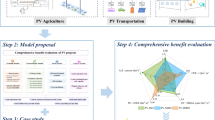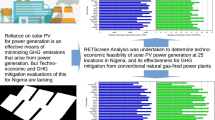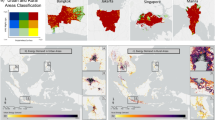Abstract
The expansion of power development industry is facing enormous pressure to reduce carbon emissions in the context of global decarbonization. Using solar energy instead of traditional fossil energy to adjust energy structure is one of the important means for reducing carbon emissions. Existing research focuses on the evaluation of the generation potential of centralized or distributed photovoltaic power plants, rather than the comprehensive evaluation of multi-type power plants. Based on multi-source remote sensing data for information extraction and suitability evaluation, this paper develops a method to comprehensively evaluate the construction potential of multi-type photovoltaic power stations and determine the potential of photovoltaic power generation and carbon emission reduction on the Qinghai–Tibet Plateau (QTP). The results showed that estimating the power generation potential of only single-type photovoltaic power stations cannot accurately reflect the photovoltaic power generation potential of QTP. It is also demonstrated that the emission reduction effect of the photovoltaic power generation in all prefecture-level cities of QTP can meet national emission reduction targets, showing high annual power generation potential, of which 86.59% is concentrated in Qinghai province’s Guoluo, Yushu, and Haixi. An accurate estimation of the photovoltaic power generation potential in QTP can provide a useful theoretical basis for developing carbon-saving and emission reduction strategies for clean energy in China.





Similar content being viewed by others
Data availability
All data generated or analyzed during this study are included in this published article.
References
Allen, J. G., Piers, M. N., Usha, S., Suresh, S., Jose, V., & Spengler, J. D. (2016). Associations of cognitive function scores with carbon dioxide, ventilation, and volatile organic compound exposures in office workers: A controlled exposure study of green and conventional office environments. Environmental Health Perspectives, 124(6), 805–812. https://doi.org/10.1289/ehp.1510037
Aly, A., Jensen, S. S., & Pedersen, A. B. (2017). Solar power potential of Tanzania: Identifying CSP and PV hot spots through a GIS multicriteria decision making analysis. Renewable Energy, 113, 159–175. https://doi.org/10.1016/j.renene.2017.05.077
Antonanzas, J., Arbeloa-Ibero, M., & Quinn, J. C. (2019). Comparative life cycle assessment of fixed and single axis tracking systems for photovoltaics. Journal of Cleaner Production, 240, 118016. https://doi.org/10.1016/j.jclepro.2019.118016
Aragones-Beltran, P., Chaparro-Gonzalez, F., Pastor-Ferrando, J. P., & Rodriguez-Pozo, F. (2010). An ANP-based approach for the selection of photovoltaic solar power plant investment projects. Renewable & Sustainable Energy Reviews, 14(1), 249–264. https://doi.org/10.1016/j.rser.2009.07.012
Assouline, D., Mohajeri, N., & Scartezzini, J.-L. (2017). Quantifying rooftop photovoltaic solar energy potential: A machine learning approach. Solar Energy, 141, 278–296. https://doi.org/10.1016/j.solener.2016.11.045
Byrne, J., Taminiau, J., Kurdgelashvili, L., & Kim, K. N. (2015). A review of the solar city concept and methods to assess rooftop solar electric potential, with an illustrative application to the city of Seoul. Renewable and Sustainable Energy Reviews, 41, 830–844. https://doi.org/10.1016/j.rser.2014.08.023
Carrión, J. A., Estrella, A. E., Dols, F. A., & Ridao, A. R. (2008a). The electricity production capacity of photovoltaic power plants and the selection of solar energy sites in Andalusia (Spain). Renewable Energy, 33(4), 545–552. https://doi.org/10.1016/j.renene.2007.05.041
Carrión, J. A., Estrella, A. E., Dols, F. A., Toro, M. Z., Rodriguez, M., & Ridao, A. R. (2008b). Environmental decision-support systems for evaluating the carrying capacity of land areas: Optimal site selection for grid-connected photovoltaic power plants. Renewable & Sustainable Energy Reviews., 12(9), 2358–2380. https://doi.org/10.1016/j.rser.2007.06.011
Chau, C. K., Leung, T. M., & Ng, W. Y. (2015). A review on life cycle assessment, life cycle energy assessment and life cycle carbon emissions assessment on buildings. Applied Energy, 143, 395–413. https://doi.org/10.1016/j.apenergy.2015.01.023
Choi, Y., Suh, J., & Kim, S. M. (2019). GIS-based solar radiation mapping, site evaluation, and potential assessment: A review. Applied Sciences, 9(9), 1960. https://doi.org/10.3390/app9091960
Clifton, J., & Boruff, B. J. (2010). Assessing the potential for concentrated solar power development in rural Australia. Energy Policy, 38(9), 5272–5280. https://doi.org/10.1016/j.enpol.2010.05.036
Corney, H. J., Sasse, J. M., & Ades, P. K. (2003). Assessment of salt tolerance in eucalypts using chlorophyll fluorescence attributes. New Forests, 26(3), 233–246. https://doi.org/10.1023/A:1024474813116
Cromar, K., Howard, P., Vásquez, V. N., & Anthoff, D. (2021). Health impacts of climate change as contained in economic models estimating the social cost of carbon dioxide. GeoHealth, 5(8), e2021GH000405. https://doi.org/10.1029/2021GH000405
Darwish, Z. A., Kazem, H. A., Sopian, K., Al-Goul, M. A., & Alawadhi, H. (2015). Effect of dust pollutant type on photovoltaic performance. Renewable & Sustainable Energy Reviews, 41, 735–744. https://doi.org/10.1016/j.rser.2014.08.068
Desideri, U., Zepparelli, F., Morettini, V., Garroni, E., & Yan, J. (2013). Comparative analysis of concentrating solar power and photovoltaic technologies: Technical and environmental evaluations. Applied Energy, 102, 765–784. https://doi.org/10.1016/j.apenergy.2012.08.033
Dincer, F. (2011). The analysis on photovoltaic electricity generation status, potential and policies of the leading countries in solar energy. Renewable & Sustainable Energy Reviews, 15(1), 713–720. https://doi.org/10.1016/j.rser.2010.09.026
Fountoukis, C., Figgis, B., Ackermann, L., & Ayoub, M. A. (2018). Effects of atmospheric dust deposition on solar PV energy production in a desert environment. Solar Energy, 164, 94–100. https://doi.org/10.1016/j.solener.2018.02.010
Gou, J. J., Miao, C. Y., Duan, Q. Y., Tang, Q. H., Di, Z. H., Liao, W. H., Wu, J. W., & Zhou, R. (2020). Sensitivity analysis-based automatic parameter calibration of the variable infiltration capacity (VIC) model for streamflow simulations over China. Water Resources Research, 56(1), e2019WR025968. https://doi.org/10.1029/2019WR025968
Gou, J. J., Miao, C. Y., Samaniego, L., Xiao, M., Wu, J. W., & Guo, X. Y. (2021). CNRD v1.0: A high-quality natural runoff dataset for hydrological and climate studies in China. Bulletin of the American Meteorological Society, 102(5), E929–E947. https://doi.org/10.1175/BAMS-D-20-0094.1
Günen, M. A. (2021). A comprehensive framework based on GIS-AHP for the installation of solar PV farms in Kahramanmaraş, Turkey. Renewable Energy, 178, 212–225. https://doi.org/10.1016/j.renene.2021.06.078
Hayami, H., Nakamura, M., & Yoshioka, K. (2005). The life cycle CO/sub 2/emission performance of the DOE/NASA solar power satellite system: A comparison of alternative power generation systems in Japan. IEEE Transactions on Systems Man & Cybernetics Part C, 35(3), 391–400. https://doi.org/10.1109/TSMCC.2004.843232
He, G., & Kammen, D. M. (2016). Where, when and how much solar is available. A provincial-scale solar resource assessment for China. Renewable Energy, 85, 74–82. https://doi.org/10.1016/j.renene.2015.06.027
Hong, T., Koo, C., Park, J., & Park, H. S. (2014). A GIS (geographic information system)-based optimization model for estimating the electricity generation of the rooftop PV (photovoltaic) system. Energy, 65(feb.1), 190–199. https://doi.org/10.1016/j.energy.2013.11.082
Hou, G., Sun, H., Jiang, Z., Pan, Z., Wang, Y., Zhang, X., Zhao, Y., & Yao, Q. (2016). Life cycle assessment of grid-connected photovoltaic power generation from crystalline silicon solar modules in China. Applied Energy, 164(feb.15), 882–890. https://doi.org/10.1016/j.apenergy.2015.11.023
Izquierdo, S., Rodrigues, M., & Fueyo, N. (2008). A method for estimating the geographical distribution of the available roof surface area for large-scale photovoltaic energy-potential evaluations. Solar Energy, 82(10), 929–939. https://doi.org/10.1016/j.solener.2008.03.007
Jamal, T., Ongsakul, W., Singh, J. G., Salehin, S., & Ferdous, S. M. (2014). Potential rooftop distribution mapping using Geographic Information Systems (GIS) for Solar PV Installation: A case study for Dhaka, Bangladesh. In 2014 3rd International Conference on the Developments in Renewable Energy Technology (ICDRET), Dhaka, Bangladesh.
Jie, Y., Ji, X., Yue, A., Chen, J., Deng, Y., Chen, J., & Zhang, Y. (2020). Combined multi-layer feature fusion and edge detection method for distributed photovoltaic power station identification. Energies, 13(24), 6742. https://doi.org/10.3390/en13246742
Karnauskas, K. B., Miller, S. L., & Schapiro, A. C. (2020). Fossil fuel combustion is driving indoor CO2 toward levels harmful to human cognition. GeoHealth, 4(5), e2019GH000237. https://doi.org/10.1029/2019GH000237
Klemeš, J., & Pierucci, S. (2008). PRES 2007: Carbon footprint and emission minimisation, integration and management of energy sources, industrial application and case studies. Energy, 33(10), 1477–1479. https://doi.org/10.1016/j.energy.2008.07.010
Lassio, J. G., Branco, D. C., Magrini, A., & Matos, D. (2022). Environmental life cycle-based analysis of fixed and single-axis tracking systems for photovoltaic power plants: A case study in Brazil. Cleaner Engineering and Technology, 11, 100586. https://doi.org/10.1016/j.clet.2022.100586
Lehmann, H., & Peter, S. (2003). Assessment of roof & façade potentials for solar use in Europe. Institute for sustainable solutions and innovations (ISUSI), Aachen, Germany.
Li, J., Wang, Y., Xu, D., & Xie, K. (2020). High-resolution analysis of life-cycle carbon emissions from China’s coal-fired power industry: A provincial perspective. International Journal of Greenhouse Gas Control, 100, 103110. https://doi.org/10.1016/j.ijggc.2020.103110
Liu, J., Xu, F., & Lin, S. (2017). Site selection of photovoltaic power plants in a value chain based on grey cumulative prospect theory for sustainability: A case study in Northwest China. Journal of Cleaner Production, 148, 386–397. https://doi.org/10.1016/j.jclepro.2017.02.012
Liu, G., Wu, W., Ge, Q., Dai, E., Wan, Z., & Zhou, Y. (2011). GIS-based assessment of roof-mounted solar energy potential in Jiangsu, China. In 2011 Second International Conference on Digital Manufacturing & Automation, Zhangjiajie, Hunan, China.
Merrouni, A. A., Elalaoui, F. E., Mezrhab, A., Mezrhab, A., & Ghennioui, A. (2018). Large scale PV sites selection by combining GIS and Analytical Hierarchy Process. Case Study: Eastern Morocco. Renewable Energy, 119, 863–873. https://doi.org/10.1016/j.renene.2017.10.044
Ou, X., Yan, X., & Zhang, X. (2011). Life-cycle energy consumption and greenhouse gas emissions for electricity generation and supply in China. Applied Energy, 88(1), 289–297. https://doi.org/10.1016/j.apenergy.2010.05.010
Ou, J., Meng, J., Zheng, H., Mi, Z., Shan, Y., & Guan, D. (2019). Frequent interactions of Tibet’s CO2 emissions with those of other regions in China. Earth’s Future, 7(4), 491–502. https://doi.org/10.1029/2018EF001059
Peng, J., & Lu, L. (2013). Investigation on the development potential of rooftop PV system in Hong Kong and its environmental benefits. Renewable & Sustainable Energy Reviews, 27, 149–162. https://doi.org/10.1016/j.rser.2013.06.030
Pillai, I. R., & Banerjee, R. (2007). Methodology for estimation of potential for solar water heating in a target area. Solar Energy, 81(2), 162–172. https://doi.org/10.1016/j.solener.2006.04.009
Qin, K., Li, J., Liu, J., Yan, L., & Huang, H. (2019). Setting conservation priorities based on ecosystem services-A case study of the Guanzhong-Tianshui Economic Region. Science of the Total Environment, 650, 3062–3074. https://doi.org/10.1016/j.scitotenv.2018.09.305
Qiu, T., Wang, L., Lu, Y., Zhang, M., Qin, W., Wang, S., & Wang, L. (2022). Potential assessment of photovoltaic power generation in China. Renewable and Sustainable Energy Reviews, 154, 111900. https://doi.org/10.1016/j.rser.2021.111900
Scartezzini, J. L., Montavon, M., & Compagnon, R. (2002). Computer evaluation of the solar energy potential in an urban environment. EuroSun.
Schallenberg-Rodríguez, J. (2013). Photovoltaic techno-economical potential on roofs in regions and islands: The case of the Canary Islands. Methodological review and methodology proposal. Renewable and Sustainable Energy Reviews, 20, 219–239. https://doi.org/10.1016/j.rser.2012.11.078
Schulze-Kegel, D., & Heidt, F. D. (1996). Mapping of global radiation with METEOSAT. Solar Energy, 58(1–3), 77–90. https://doi.org/10.1016/0038-092X(96)00017-5
Shelhamer, E., Long, J., & Darrell, T. (2016). Fully convolutional networks for semantic segmentation. IEEE Transactions on Pattern Analysis and Machine, 39(4), 640–651. https://doi.org/10.1109/TPAMI.2016.2572683
Sherwani, A. F., & Usmani, J. A. (2010). Life cycle assessment of solar PV based electricity generation systems: A review. Renewable and Sustainable Energy Reviews, 14(1), 540–544. https://doi.org/10.1016/j.rser.2009.08.003
Singh, R., & Banerjee, R. (2015). Estimation of rooftop solar photovoltaic potential of a city. Solar Energy, 115, 589–602. https://doi.org/10.1016/j.solener.2015.03.016
Stoppato, A. (2008). Life cycle assessment of photovoltaic electricity generation. Energy, 33(2), 224–232. https://doi.org/10.1016/j.energy.2007.11.012
Sumper, A., Robledo-García, M., Villafáfila-Robles, R., Bergas-Jané, J., & Andrés-Peiró, J. (2011). Life-cycle assessment of a photovoltaic system in Catalonia (Spain). Renewable and Sustainable Energy Reviews, 15(8), 3888–3896. https://doi.org/10.1016/j.rser.2011.07.023
Sun, H., Zhi, Q., Wang, Y., Yao, Q., & Su, J. (2014). China’s solar photovoltaic industry development: The status quo, problems and approaches. Applied Energy, 118, 221–230. https://doi.org/10.1016/j.apenergy.2013.12.032
Wang, S., Fang, C., Ma, H., Wang, Y., & Qin, J. (2014). Spatial differences and multi-mechanism of carbon footprint based on GWR model in provincial China. Journal of Geographical Sciences, 24(4), 612–630. https://doi.org/10.1007/s11442-014-1109-z
Wang, L. Z., Tan, H. W., Ji, L., & Wang, D. (2017). A method for evaluating photovoltaic potential in China based on GIS platform. Iop Conference, 93(1), 012056. https://doi.org/10.1088/1755-1315/93/1/012056
Wang, P., Zhang, S., Pu, Y., Cao, S., & Zhang, Y. (2021). Estimation of photovoltaic power generation potential in 2020 and 2030 using land resource changes: An empirical study from China. Energy, 219, 119611. https://doi.org/10.1016/j.energy.2020.119611
Wang, B. Z. (1983). Solar energy resource division in China. Acta Energiae Solaris Sinica, a(03), 221–228.
Wei, L., Li, Y., Su, Y., & Chi, Y. (2016). Research on economy and technology feasibility for centralized solar power development in Qinghai-Tibet Plateau. 2016 IEEE PES Asia-Pacific Power and Energy Engineering Conference (APPEEC), Xian, Shanxi, China.
Wiginton, L. K., Nguyen, H. T., & Pearce, J. M. (2010). Quantifying rooftop solar photovoltaic potential for regional renewable energy policy. Computers Environment and Urban Systems, 34(4), 345–357. https://doi.org/10.1016/j.compenvurbsys.2010.01.001
Wu, W., Cao, Y., Cao, W., Xu, J., & Wang, Y. (2006). Spatial structure and evolution of highway accessibility in the Yangtze River delta. Acta Geographica Sinica, 61(10), 1065–1074. https://doi.org/10.1016/S1005-8885(07)60093-4
Yager, R. R. (1988). On ordered weighted averaging aggregation operators in multicriteria decisionmaking. IEEE Transactions on Systems, 18(1), 183–190. https://doi.org/10.1109/21.87068
Yager, R. R. (1996). Quantifier guided aggregation using OWA operators. International Journal of Intelligent Systems, 11(1), 49–73. https://doi.org/10.1002/(SICI)1098-111X(199601)11:1%3c49::AID-INT3%3e3.0.CO;2-Z
Yang, Q., Huang, T., Wang, S., Li, J., Dai, S., Wright, S., Wang, Y. X., & Peng, H. (2019). A GIS-based high spatial resolution assessment of large-scale PV generation potential in China. Applied Energy, 247, 254–269. https://doi.org/10.1016/j.apenergy.2019.04.005
Zhang, Q., Xin, X., Zhang, H., Li, Y., Li, X. J., & Yi, C. H. (2018). Suitability analysis of photovoltaic power plants in China using remote sensing data and multi-criteria evaluation. Journal of Geo-information Science, 20(1), 119–127. https://doi.org/10.12082/dqxxkx.2018.170393
Funding
This research is supported by The Second Tibetan Plateau Scientific Expedition and Research (STEP) program (Grant No. 2019QZKK0608).
Author information
Authors and Affiliations
Contributions
Dongchuan Wang, Ming Qu, and HongYi Wang conceived and designed the research; Dongchuan Wang and YingYi Ma supervised the research group; Ming Qu and HongYi Wang drafted the article; Ming Qu and HongYi Wang collected and processed the data; Ming Qu, HongYi Wang, and KangJian Wang made the data analysis; Dongchuan Wang and YingYi Ma discussed and modified the original manuscript, and ShiJie Jia, shuping Zhang and ChangJin Yu polished the language of the paper. All authors have revised the article critically and approved the final manuscript.
Corresponding author
Ethics declarations
Competing interests
The authors declare no competing interests.
Additional information
Publisher's note
Springer Nature remains neutral with regard to jurisdictional claims in published maps and institutional affiliations.
Rights and permissions
Springer Nature or its licensor (e.g. a society or other partner) holds exclusive rights to this article under a publishing agreement with the author(s) or other rightsholder(s); author self-archiving of the accepted manuscript version of this article is solely governed by the terms of such publishing agreement and applicable law.
About this article
Cite this article
Wang, D., Wang, H., Qu, M. et al. Suitability evaluation and potential estimation of photovoltaic power generation and carbon emission reduction in the Qinghai–Tibet Plateau. Environ Monit Assess 195, 887 (2023). https://doi.org/10.1007/s10661-023-11439-8
Received:
Accepted:
Published:
DOI: https://doi.org/10.1007/s10661-023-11439-8




